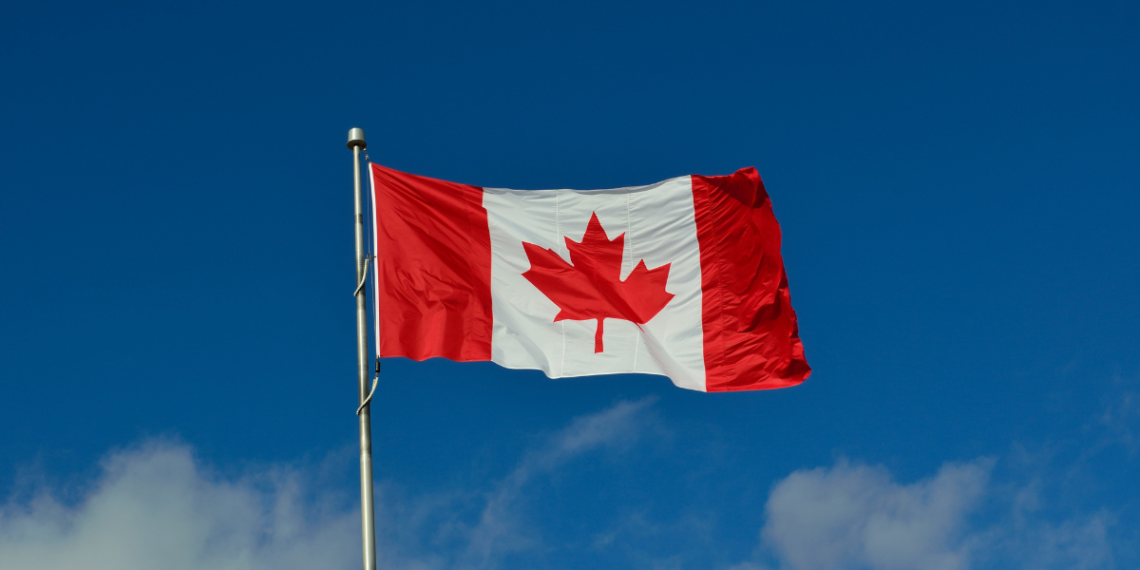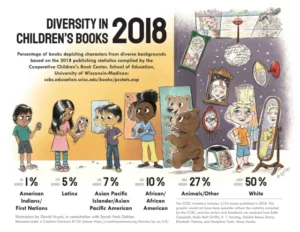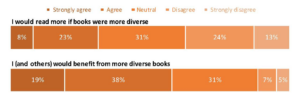
“Diversity” in Traditional Canadian Publishing
The Mandates Have Changed Why Haven’t We?
“Diversity is a standard that has to be lived up to in practice, not an empty buzzword” (Shraya 2019).
There is no arguing that diversity is needed in books, whether it is already there or not. BookNet Canada shares that in a 2021 survey, “41% of respondents said that they feel that at least one dimension of their identity is not represented by the dominant group at least some of the time” (BookNet Canada 2021). An upsetting infographic created by David Huyck and Sarah Park Dahlen and shared in the Huffpost article; Kids Books Still Have A Lack-Of-Diversity Problem, Powerful Image Shows. In this graphic, we observe that many kids are missing out on seeing themselves in published books. Although this is an American infographic, the article reveals it is a problem in Canada too, which is proven by a Breakdown of diversity in Canadian children’s books in 2018 in a 2019 The Star Vancouver article. They also shared that “at the middle-grade level the breakdown was 58.1 percent white and 17.3 percent POC, and at the YA level there was a ratio of 50.4 percent white to 26 percent POC” (Dundas 2019).

Image 1. Diversity in Children’s Books 2018
Diverse books indicates “books about or from the point of view of Black, Indigenous, and/or people of colour (BIPOC), LGBTQ+ people, people who are disabled or differently-abled, religious minorities, and/or books by authors who identify as members of one or more of the listed groups” (BookNet Canada 2019). Diversity is needed and a word that can be placed haphazardly into mandates within many industries, including publishing. If you are going to use the word diversity, make sure you can back it up.
Vivek Shraya shares 13 Ways to Diversify Your Press in a 2016 article with AllLitUp. Suggestion 4 is to Reword Your Mandate, where Vivek highlights some ideas on a new mandate for your publishing industry that includes “acknowledging historical and systemic barriers” (Shraya 2019), and the limits of the publishing houses existing catalogue.
Let’s Look at The Mandates
Key Publishing House (KPH) Inc. is a great example of a publishing press that changed its mandate to fit the current state of its publishing house. In 2017, KPH’s mandate stated that they were a diverse publisher, and in 2020 they changed their mandate to state they are a progressive publisher, expressing that they are “guided by the values of integrity, transparency, accountability, respect, and tolerance” (“About Us” 2021).
There are other publishing houses that talk the talk and walk the walk. Anvil Press, Talonbooks, and Arsenal Pulp Press are great examples of publishers that say precisely what type of books they include in their diversity. To them, it is not a buzzword. You can see in Talonbook’s Fall 2020 Catalogue this diverse list on full display.
Orca is another great example, and in their mandate, they share that they are, “Providing young people with exposure to diversity through reading creates a more compassionate world” (“About Us Orca” 2021). In February 2021, Orca even showcased a diverse group of authors in a Get To Know Us panel, which Vivek Shraya suggested in her article.
Other publishers such as Penguin Random House Canada, Invisible Publishing and HarperCollins Publishing were included in the FOLD (The Festival of Literary Diversity) 2021 Booklist.
Great! So if this is the case, why are we talking about this?
These changes aren’t indicative of the entire issue. Some presses publishing diverse books don’t change an industry that is “discriminatory by design” (McGrath 2019).
There are presses such as Gordon Hill Press that have little follow through with their diversity statements. Gordon Hill Presses mandate says they have a “wide diversity of writers” (“About” 2021), and while they do acknowledge that this is particularly writers living with disabilities, their author’s collection is overwhelmingly white. Vivek Shraya highlighted this problem, saying, “Whiteness tends to dominate in every arena, including sexuality and gender, so even a “diverse” booklist remains overwhelmingly white” (Shraya 2019).
Although Vivek Shraya shares 13 fantastic ways to diversify your publishing press, they won’t work because only a small amount seems to follow these suggestions. Why won’t they follow through? I have highlighted five reasons below.
Why We Haven’t Changed:
The curatorial paradigm is a unique signature that each publishing house has and limits its catalogue (Bhaskar 2019). “When publishers say ‘This is our kind of book’ or ‘Oh, that’s definitely not one for us,’ they are obliquely referring to the curatorial paradigm” (Bhaskar 2019). It exists within the traditional publishing sectors as it is conditioned into staff and modelled in the higher levels, unlike within self-published works.
This curatorial paradigm can be limiting, usually based on the ‘taste’ of a few individuals and their unconscious bias. In a time when many decisions in businesses are data-driven, “editorial selection is still to some extent based on ‘gut’ or subjective choice” (Bhaskar 2019).
But the curatorial paradigm can be dynamic and modified with changes in boundaries and guidelines and changes in control and staffing.
2) Positions of Power Change Slowly
People change slowly, for a multitude of reasons, and we cannot wait that long. Changing the people in positions of power may fix the problem, but it is not a viable option due to ‘laws.’
But even if we cannot just fire all of the executives, it remains a problem for diversity within publishing houses. For example, Penguin Random House Canada boasts that 50% of their executive team is women); however, if you look at the 2018 Canadian Book Publishing Diversity Baseline Survey, only 18% of the publishing industry in Canada is men and 74% of the industry is women.

Image 2. Penguin Random House
If Penguin Random House Canada followed this tendency, and they had (for simplicity) 200 full-time staff and a ten-person executive team. 13.89% of all men working for them would-be executives and only 3.29% of all women working there would-be executives. They are BOASTING about this, which means it is not the industry standard to have 50% female executives.
Although the numbers for sexual orientation heavily favour heterosexuality, and the numbers for race favour white, it is hard to see how bad the problems are without learning how many of those are in positions of power. Do they affect the curatorial paradigm? Were they a part of a group hire, or are they experiencing extreme burnout?
3) Without Momentum, Mandates Do Nothing
There is momentum right now regarding Indigenous Reconciliation within Canada, showcased in Penguin Random House Canada’s Decolonizing Publishing event, but when does that momentum die out? Who has to hold publishing houses accountable after they do their 101 and complete their “programming” (Bland, 2021). It is much easier to change the mind of peers, those who have had a similar upbringing and those we can relate to than it is to change the minds of our bosses.
Change rarely happens through much else than social pressure. Michael Bhaskar mentions the Concentric rings of influence in that Curation in Publishing: Curatorial Paradigms, Filtering, and the Structure of Editorial Choice. The outer rings focus on markets, macro ideologies and economic factors. These outer rings usually cause the curatorial paradigms to be reactive – readjusting to the market (Bhaskar 2019).
4) Money (and fear of losing it)
Money is important for three reasons; personal risk, business and Canadian funding. Bhaskar mentions that people’s sense of their careers impacts their decision-making (Bhaskar 2019). With the fear of job loss, can publishers change the publishing industry? Obviously, there is no harm in trying because even a dent is something.
Another fear that publishers face is ‘what if this book doesn’t do well?’ A way that publishers decide on books is through comparable titles that performed well. However, many critics have brought up a great question: What if there are no comps? The article Comping White explains how comps “have become prescriptive (“this book should be like that book”) and restrictive (“…or we can’t publish it”)” (McGrath 2019). In this case, if there is nothing to compare it to, will diverse books ever be published? Publishers may fear taking that financial risk on a book that they do not know will sell.
Part of the problem with comparative titles is the assumption that the audience doesn’t change. The Guardian writer, Alison Flood, shares the core audience of many major publishers, which tend to dominate the market, still “assume that audiences are white and middle class, and undervalue black, Asian and minority ethnic and working-class audiences” (Flood 2020). This audience parallels who runs the publishing industry, taking us back to bias continued by the curatorial paradigm and built by those in power.
Even if this is the audience, they aren’t giving enough credit to those who want to read more diverse books. BookNet Canada shared that 17% of those who took a 2021 diversity survey said they had read more diverse books in the previous year, and 31% said they sometimes had read more diverse books (BookNet Canada 2021).
BookNet Canada also shares that many Canadians say they would read more if books were diverse, which would increase the current audience (BookNet Canada 2019).

Image 3. Diverse Books
Looking back at the diversity statistics where The Star Vancouver article shared the overwhelming whiteness within book publishing, even if people want to read diverse books, there isn’t enough of them. Printing books without comps may have to be the norm until a catalogue can be built.
The third reason is a fear of losing support from Canadian institutions which allows for internalized traditionalism. However, much of it might be misplaced as Heritage Canada (which runs the Canadian Book Fund) has been focused on building an anti-racism strategy since 2019. Furthermore, within BC Arts Council eligibility for Canadian publishers, the funds are meant to “develop and promote Canadian literature and Canadian writers” (BC Arts Council 2019).
So… What Now?
Despite studies showing that people are interested in reading diverse books, gatekeepers will remain within a traditional publishing industry due to fear and lack of change.
What we have to do is keep pushing from outside of the industry. Get peers interested and listening, and with enough social pressure and enough time, one day, white will no longer be the default.
Bibliography
“About Arsenal Pulp Press.” 2021. Arsenalpulp.com. 2021. https://arsenalpulp.com/About-Arsenal-Pulp-Press (Links to an external site.).
“About.” 2021. Gordon Hill Press. 2021. https://www.gordonhillpress.com/pages/about (Links to an external site.).
“About Talon» Talonbooks.” 2021. Talonbooks.com. 2021. https://talonbooks.com/about/ (Links to an external site.).
“About Us Orca.” 2021. Www.orcabook.com. 2021. https://www.orcabook.com/About.aspx.
“About Us.” 2021. The Key Publishing House Inc. 2021. https://thekeypublish.com/about-us/ (Links to an external site.).
“Anvil Press: About.” 2021. Www.anvilpress.com. 2021. https://www.anvilpress.com/about (Links to an external site.).
Association of Canadian Publishers. 2019. “2018 Canadian Book Publishing Diversity Baseline Survey.” Association of Canadian Publishers. https://publishers.ca/wp-content/uploads/2019/03/2018-Diversity-Survey-Summary-Report.pdf.
“Authors.” 2021. Gordon Hill Press. 2021. https://www.gordonhillpress.com/collections/authors (Links to an external site.).
BC Arts Council. 2019. “Project Assistance: Book Publishers | BC Arts Council.” BC Arts Council. June 20, 2019. https://www.bcartscouncil.ca/program/book-publishers-2/.
Bland, J., 2021. thank you!. [email].
BookNet Canada. 2019. “Demand for Diversity: A Survey of Canadian Readers.” BookNet Canada. May 3, 2019. https://www.booknetcanada.ca/blog/2019/5/3/demand-for-diversity-a-survey-of-canadian-readers (Links to an external site.).
BookNet Canada. 2021. “On Diversity: The Need for Diverse Books Is Still Here.” BookNet Canada. September 7, 2021. https://www.booknetcanada.ca/blog/2021/9/7/on-diversity-the-need-for-diverse-books-is-still-here.
Bhaskar, Michael. 2019. “Curation in Publishing: Curatorial Paradigms, Filtering, and the Structure of Editorial Choice.” The Oxford Handbook of Publishing 35 (4). https://doi.org/10.1007/s12109-019-09698-w (Links to an external site.).
Canadian Heritage. 2019. “Building a Foundation for Change: Canada’s Anti-Racism Strategy 2019–2022.” Canada. https://www.canada.ca/en/canadian-heritage/campaigns/anti-racism-engagement/anti-racism-strategy.html.
“Canadian Publishers: List of Publishers in Canada | PublishersGlobal.com.” n.d. Www.publishersglobal.com. Accessed October 18, 2021. https://www.publishersglobal.com/directory/canada/publishers-in-canada (Links to an external site.).
“Changing the World, One Book at a Time.” 2020. Penguin Random House Canada. 2020. https://www.google.com/url?q=https://www.penguinrandomhouse.ca/top-employer&sa=D&source=docs&ust=1634531851409000&usg=AOvVaw1rhaDIwBgDNnpfU3v6nu8x (Links to an external site.).
Dundas, Deborah. 2019. “Who Do We See in Kids’ Books? Star Survey Puts Numbers to the State of Diversity.” The Toronto Star, October 25, 2019, sec. Books. https://www.thestar.com/entertainment/books/2019/10/25/who-do-we-see-in-kids-books-star-survey-puts-numbers-to-the-state-of-diversity.html (Links to an external site.).
Flood, Alison. 2020. “‘Black and Asian People Not Seen as Readers’: Bernardine Evaristo Condemns Books Industry.” The Guardian. June 23, 2020. https://www.theguardian.com/books/2020/jun/23/black-and-asian-people-not-seen-as-readers-bernardine-evaristo-condemns-books-industry.
“FOLD 2021 Booklist.” 2021. The FOLD. 2021. https://thefoldcanada.org/fold-2021-booklist/ (Links to an external site.).
Heritage, Canadian. 2018. “Funding – Culture, History and Sport – Canada.ca.” Canada.ca. 2018. https://www.canada.ca/en/canadian-heritage/services/funding.html.
McGrath, Laura B. 2019. “Comping White.” Los Angeles Review of Books. January 21, 2019. https://lareviewofbooks.org/article/comping-white/.
“Orca Book Publishers #GetToKnowHiLo Panel.” 2021. Canadian Children’s Book Centre. 2021. https://bookcentre.ca/events/orca-book-publishers-gettoknowhilo-panel.
Shraya, Vivek. 2019. “#PublishingSoWhite: 13 Ways to Diversify Your Press.” Alllitup.ca. February 16, 2019. https://alllitup.ca/Blog/2016/PublishingSoWhite-13-Ways-to-Diversify-Your-Press (Links to an external site.).
Stechyson, Natalie. 2019. “Most Kids Books Are about White People, Then Animals. That’s a Problem.” HuffPost. June 21, 2019. https://www.huffpost.com/entry/diversity-kids-books-statistics_l_61087501e4b0497e67026f1c.
“Talonbooks 2020 Fall Catalogue.” 2020. Talonbooks.com. June 22, 2020. https://talonbooks.com/catalogues/talonbooks-2020-fall-catalogue (Links to an external site.).
“The Key Publishing House Inc.” 2017. Book Publishing Companies. August 6, 2017. https://www.everywritersresource.com/bookpublishers/2017/08/06/the-key-publishing-house-inc/ (Links to an external site.).




